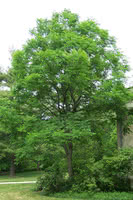Mon-Fri 9am - 5pm Mountain time
Common Hackberry vs Kentucky Coffeetree
Gymnocladus dioicus
Celtis occidentalis
NOT AVAILABLE THIS SEASON - MIGHT RETURN
The Kentucky Coffeetree has the largest leaves of any native tree in North America! In the summer, its large green canopy provides shade. While in the winter, its leathery bean pods act as a decorative element against the sky as they rattle in the wind. Beautiful year-round, this tree is an elegant addition to any landscape.
The Common Hackberry is a medium-sized deciduous tree that resembles the American Elm but is immune to Dutch Elm Disease. They are versatile and can adapt to a variety of growing conditions.
It produces purple-red, berry-like fruit with a large seed in the center. Both the sweet flesh, which tastes similar to dates, and the crunchy seed are edible. The fruit remains on the tree throughout the winter, offering a valuable food source for birds and other wildlife.
The Common Hackberry can also be a great addition to a pollinator garden. The tree itself is a host for the larvae of several butterfly species and the flowers provide a source of pollen and nectar.
Kentucky Coffeetree Quick Facts
Common Hackberry Quick Facts
Toxicity: Uncooked pods are toxic to humans

